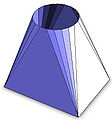Sheet metal processing
As a flat pattern or circuit board of the unbent state is a metal sheet designated for the production of a sheet product by bending is required.
When designing products made of sheet metal, the desired shape of the finished folded part is usually determined first and then the necessary development is determined. For this purpose, 3D CAD systems are used in practice , which can create the development almost automatically based on the finished part geometry, z. B.
- NX (Siemens)
- HiCAD
- SolidWorks
- Autodesk Inventor
- MegaCAD Unfold & Special Shapes
- IMC software
- CATIA V5
- OneSpace Modeling
- SolidEdge
- Rhinoceros 3D
- Form-Z (software)
- TouchCAD
- Alibre design
- Bendex3D .
To determine a suitable sheet metal development, a suitable method for determining the bending shortening is required.
The descriptive geometry also provides procedures for processing cones and other transition pieces, also by folding or by rounding rolls are made. In Fig. 2 you can see the idealized representation of a round-angular transition piece. To create a sheet metal development, the model is (mentally) faceted (Fig. 3) and can then be developed (Fig. 4).
literature
- Laskowski, Max; John, Georg: Practical sheet metal processing. Instructions for draftsmen, scribers, boiler, container and apparatus builders [...]. Berlin: Huss-Medien, 2008, ISBN 978-3-341-01545-2



